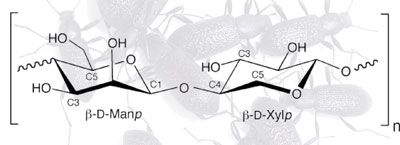
Posted on 11/24/2009 10:35:07 PM PST by neverdem
Scientists in the US have discovered a new class of biological antifreeze molecules - the first that do not contain proteins. The antifreeze, extracted from an Alaskan beetle capable of surviving at -60°C, consists of linked mannopyranose and xylopyranose sugars, termed xylomannan, associated with a lipid.
Large molecules that cause thermal hysteresis - a difference between the melting and freezing points of a solution - have been identified in many organisms that survive in the cold, from Antarctic fish to plants and bacteria. In all cases identified so far, thermal hysteresis appears to be caused by proteins, known as antifreeze proteins or AFPs.
Kent Walters was attempting to isolate and purify the AFP from the freeze-tolerant Arctic darkling beetle Upis ceramboidesas part of his PhD thesis at the University of Notre Dame in Indiana. 'He tried unsuccessfully to do so over the course of nearly two years,' says his then supervisor Jack Duman. 'The sample that he isolated had thermal hysteresis activity, but there was no protein associated with it.'
Working with colleagues from Notre Dame and the Institute of Arctic Biology at the University of Alaska Fairbanks, the researchers identified the novel thermal hysteresis factor (THF) as a xylomannan in association with a fatty acid, which was largely located on cell membranes.

|
The researchers' proposed disaccharide core structure comprising the THF isolated from the U. ceramboides beetle
© Dr Oivind Toien/ Proc. Natl. Acad. Sci
|
It is likely that the antifreeze produces thermal hysteresis by binding to ice crystals and preventing them from growing, as do AFPs says Duman. However, what the researchers do not know, is how the antifreeze functions physiologically in the freeze-tolerant beetle. 'Freeze-tolerant organisms are generally only tolerant of extracellular ice; intracellular - cytoplasmic - freezing is typically lethal,' explains Duman. 'However, the bulk of the xylomannan antifreeze is membrane-bound, and our working hypothesis is that its location on the cell membrane places it in a position to prevent the lethal inoculation of the cytoplasm across the cell membrane from the extracellular ice.'
Jeffrey Bale, at the University of Birmingham in the UK, is an expert on how insects survive in cold conditions. 'These results take our understanding of this subject to a new level,' he says. 'Not only is this the first thermal hysteresis factor to be structurally characterised from a freeze-tolerant species, the study has identified a totally new class of compounds that can produce a hysteretic effect equivalent to that of proteins.' As a next step, Bale says it will be fascinating to investigate the co-existence of proteins and xylomannan-like compounds in insects, and whether the properties of THFs could be exploited through genetic engineering.
For most simple chemical compounds, the melting point and the freezing point is the same.
Being able to survive at -60C without adding to global warming is VERY IMPRESSIVE. This is a serious beetle.
Disclaimer: Opinions posted on Free Republic are those of the individual posters and do not necessarily represent the opinion of Free Republic or its management. All materials posted herein are protected by copyright law and the exemption for fair use of copyrighted works.